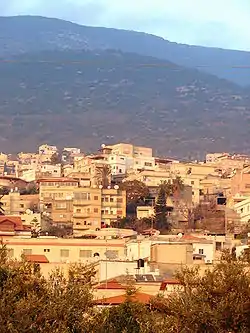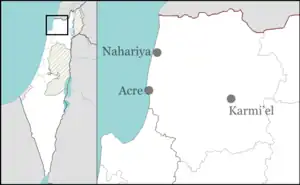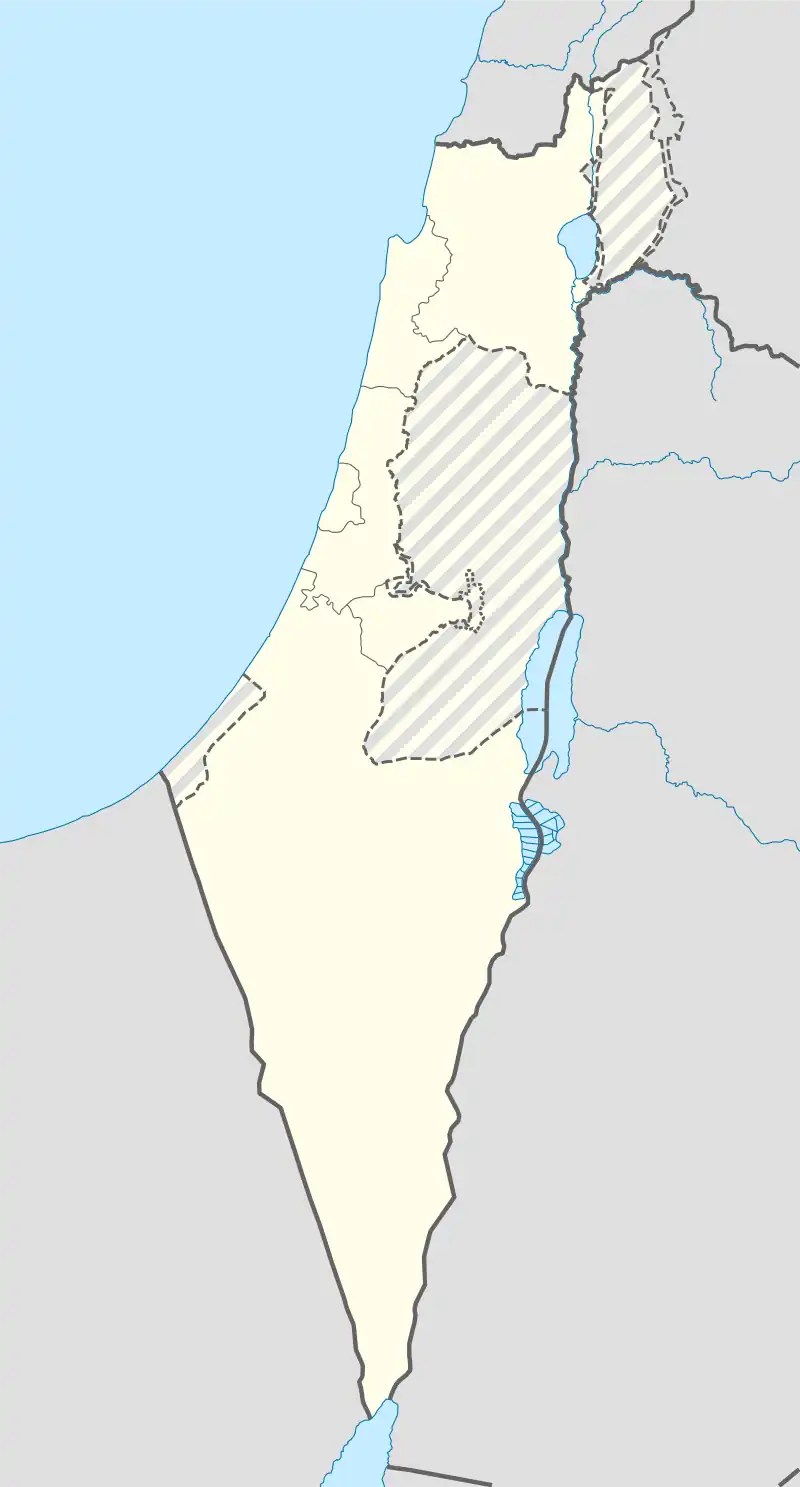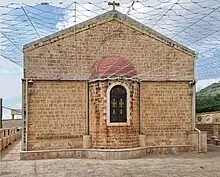Rameh
| |
|---|---|
Local council (from 2005) | |
| Hebrew transcription(s) | |
| • ISO 259 | Ráma |
| • Also spelled | Rame (official) al-Rama (unofficial) |
 | |
 Rameh  Rameh | |
| Coordinates: 32°56′21″N 35°22′02″E / 32.93917°N 35.36722°E | |
| Grid position | 184/260 PAL |
| Country | |
| District | Northern |
| Area | |
| • Total | 6,118 dunams (6.118 km2 or 2.362 sq mi) |
| Population (2021)[1] | |
| • Total | 7,789 |
| • Density | 1,300/km2 (3,300/sq mi) |
| Name meaning | "Lofty" or "Elevated"[2] |
Rameh (Arabic: الرامة; Hebrew: רָמָה; alternatively spelled ar-Rame or ar-Rama) is an Arab town in the Northern District of Israel. Located east of Nahf and Karmiel, in 2021 it had a population of 7,789.[1] Over half of the inhabitants are Christians, mostly Greek Orthodox and Greek Catholic, over a third are Druze and the remainder are Muslims.
A village council was established for Rameh under the British in 1922, of the first in Mandatory Palestine. Rameh's Christian and Muslim residents were temporarily expelled after its capture by Israeli forces in the 1948 Arab-Israeli War, but they returned to the village, which also became home to many internally displaced Palestinians from nearby villages. A village council was established in 1954 by the Israeli government to oversee village affairs; from 1959 on, council members were elected. As of the 1960s, the people of Rameh have been noted for their high levels of education and standards of living. The village was home to the well-known poet Samih al-Qasim, the Greek Orthodox archbishop Atallah Hanna and artist Mira Awad.
The village is well known for its diverse cuisine, which draws many visitors from across the country. It is also noteworthy for being surrounded by vast olive groves and for producing high-quality olive oil.[3][4]
Location
The village is situated on an ancient site, atop a hill at the edge of Beit HaKerem Valley.
History
Edward Robinson identifies Rameh with the ancient Ramah of Asher (Joshua 19:29), citing its location and ancient sarcophagi discovered on a hill outside the village as evidence.[5]
Late antiquity
Rameh features ruins of several structures dating from the Late Roman and Byzantine periods. To the east are remains of Roman baths, dating to the 2nd to 4th century, and oil presses from the same period. South and southeast of the village, remains of building foundations were discovered, including an Aramaic inscription on a lintel, which indicate a 3rd to 4th-century synagogue. To the northeast of the Roman bath are the remains of a large basilica. It was excavated in 1972 and very large column bases were found, together with polychrome mosaics representing fauna and flora.[6][7]
Many remains of pottery vessels dated to the Late Roman period (4th–5th centuries CE) have also been found,[8] together with building remains from the Byzantine period.[9]
Ottoman period
In 1517, Rameh was with the rest of Palestine incorporated into the Ottoman Empire after it was captured from the Mamluks, and by 1596, it was a village under the administration of the nahiya ("subdistrict") of Akka (Acre), part of Safad Sanjak, with a population of 96 households, all Muslim. It paid taxes on silk spinning (dulab harir),[10] goats, beehives, and a press that was used for processing either olives or grapes, in addition to paying a fixed, or lump sum; a total 21,986 akçe. Half of the revenue went to a waqf (religious endowment).[11][12]
A map from Napoleon's invasion of 1799 by Pierre Jacotin showed the place, named as "Ramah".[13] Rameh was entirely destroyed in the Galilee earthquake of 1837, with 180 of its inhabitants killed.[14] The following year, Rameh was noted as Christian and Druze village in the Shaghur district, located between Safed, Acre and Tiberias.[15][16] Victor Guérin visited the village in 1875, and found it to have 800 inhabitants, half Christian and half Druze.[17] In 1881 the PEF's Survey of Western Palestine (SWP) described it as "a village, built of stone, of good materials, containing a Greek chapel and about 600 Christians and 500 Druzes; it is situated in plains, with large olive-groves, gardens and vineyards; five perennial springs near the village, and several cisterns in it."[18] A population list from about 1887 showed that Rameh had about 1,125 inhabitants; 575 Muslims, 425 Druze and 125 Greek Catholics.[19]
British Mandatory period
Under the British Mandatory administration in Palestine, a municipal council was established for Rameh on 15 October 1922.[20] In the 1922 census of Palestine, Rameh had a total population 847; 624 Christians, 195 Druze and 28 Muslims.[21] Among the Christians, 474 were Greek Orthodox, 47 Roman Catholics, 102 Greek Catholic (Melkites) and one Maronite.[22] The population increased in the 1931 census to 1,142 residents living in 254 houses. The religious breakdown of the population was 746 Christians, 326 Druze and 70 Muslims.[23]
In the 1945 statistics Rameh had a population of 1,690; 1,160 Christians, 440 "others"(Druze), and 90 Muslims.[24] with 24,516 dunams of land, according to an official land and population survey.[25] Of this, 8,310 dunams were plantations and irrigable land, 3,078 used for grains,[26] while 56 dunams were built-up land.[27]
State of Israel

Rameh was captured by Israeli forces from the Golani Brigade without resistance on 30 October 1948 following Operation Hiram.[28] Another Israeli unit entered the village during the next day and expelled 1,000 of its Muslim and Christian inhabitants on the threat of death, though the Druze were allowed to remain.[29] The historian Benny Morris surmises that the expulsion order may have been driven by local Druze pressure to expel Rameh's Christians or a punitive response to the public support from one of Rameh's leading Christian notables, Father Yakub al-Hanna, for Fawzi al-Qawuqji, the leader of the Arab Liberation Army (ALA), one of the principal Arab forces in the Galilee during the 1948 Arab-Israeli war.[29] The Israeli unit departed the village on 5 November and Rameh's expelled residents returned to the village after having camped out in the surrounding wadis (dry river beds) and caves.[29] Their return was likely enabled by the intervention of the Israeli officer Ben Dunkelman of the 7th Brigade, who protested the expulsion order.[29] Many Christians expelled from the captured village of Iqrit settled in Rameh.[30]
In 1954 a local council was appointed to administer Rameh's local affairs.[31] Members of the 13-council were elected for the first time in 1959.[31] In 1989 Fathinah Hana was elected head of Rameh's local council, one of three Arab women elected heads of municipal or local councils in Israel, the other two being Samiyah Hakhim in Nazareth and Nahidah Shehadeh in Kafr Yasif; before them, only one Arab woman in Israel had been elected to the position, Violet Khoury of Kafr Yasif in 1979–1988.[32] Rameh is home of the Abu Latifs, a Druze crime family which operate mainly in the north, and one of main three Arab crime organizations in Israel.[33]
Demography

53% of the residents of Rameh are Christian,[34] 31% are Druze[35] and 16% are Muslim.
Writing in the 1960s, the historian Jacob Landau noted that Rameh was "distinguished by its high level of education and standard of living, expressed in the home, dress and general behaviour".[31] At the time at least, the Greek Orthodox community was the largest religious group in the village and held the most influence over its local affairs, followed by the Greek Catholics (Melkites).[31] The Druze maintained significant numbers in Rameh, but were politically divided at the time into two factions, while the smaller Christian communities, namely the Roman Catholics, and the Muslims, most of whom were internally displaced refugees from nearby villages, wielded little political influence.[31] The Druze of Rameh are generally known to be the "least traditionally minded [Druze] in Israel", according to the historian Robert Betts.[36]
Notable people
In alphabetical order by surname, article excluded:
- Mira Awad (born 1975), singer, actress, and songwriter
- Angelina Fares (born 1989), gymnast, 2007 Miss Israel beauty pageant contestant and subject of "Lady Kul El-Arab" documentary film; born in Rameh
- Basel Ghattas (born 1956), politician, Balad party, member of the Knesset (2013–2015-...)
- Jacob Hanna, biologist at the Weizmann Institute of Science who make the first synthetic embryos
- Archbishop Theodosios (Hanna) of Sebastia (born 1965), clergyman, Greek Orthodox Patriarchate of Jerusalem
- Reem Kassis, Palestinian culinary writer whose father was from Rameh[37]
- Hanna Mwais (1913–1981), politician, member of the Knesset for Hadash (1977–1981)
- Elias Nakhleh (1913–1990), politician, member of the Knesset (1959–1974)
- Samih al-Qasim (1939–2014), poet of Palestinian Druze descent
See also
References
- 1 2 "Regional Statistics". Israel Central Bureau of Statistics. Retrieved 22 February 2023.
- ↑ Palmer, 1881, p. 92
- ↑ "האם שמן הזית הטוב בעולם נמצא בכפר ראמה? לפי תושביו התשובה היא כן". הארץ (in Hebrew). Retrieved 2023-03-24.
- ↑ "אוכל גלילי אותנטי, ערק ייחודי ומטבח בולגרי. כל הסיבות לבקר בראמה". הארץ (in Hebrew). Retrieved 2023-03-24.
- ↑ Robinson, 1856, pp. 64-65.
- ↑ Marmorstein, A. (1933). "The Inscription of Er-Rame". Palestine Exploration Quarterly. 65 (2): 100–101. doi:10.1179/peq.1933.65.2.100. ISSN 0031-0328.
- ↑ Dauphin 1998, p. 705
- ↑ Cinamon, 2009, Er-Rama
- ↑ Dalali-Amos 2011, Er-Rama
- ↑ Rhode 1979, p. 145 for the silk tax, and p. 5 for the date.
- ↑ Hütteroth and Abdulfattah, 1977, p. 190
- ↑ Note that Rhode, 1979, p. 6 writes that the register that Hütteroth and Abdulfattah studied from Safad Sanjak was not from 1595/96, but from 1548/49.
- ↑ Karmon 1960, p. 166
- ↑ The earthquake of 1 January 1837 in Southern Lebanon and Northern Israel by N. N. Ambraseys, in Annali di Geofisica, Aug. 1997, p. 933
- ↑ Robinson and Smith, 1841, vol. 3, 2nd appendix, p. 133
- ↑ Robinson and Smith 1841, vol. 3,p. 250
- ↑ Guérin, 1880, p. 453
- ↑ Conder and Kitchener 1881, p. 204
- ↑ Schumacher 1888, p. 174
- ↑ Tsimhoni 1984, p. 192, note 127.
- ↑ Barron, 1923, Table XI, Sub-district of Acre, p. 36
- ↑ Barron 1923, Table XVI, p. 50
- ↑ Mills 1932, p. 102
- ↑ Government of Palestine, Department of Statistics, 1945, p. 4
- ↑ Government of Palestine, Department of Statistics. Village Statistics, April, 1945. Quoted in Hadawi, 1970, p. 41
- ↑ Government of Palestine, Department of Statistics. Village Statistics, April, 1945. Quoted in Hadawi, 1970, p. 81
- ↑ Government of Palestine, Department of Statistics. Village Statistics, April, 1945. Quoted in Hadawi, 1970, p. 131
- ↑ Morris, pp. 476–478.
- 1 2 3 4 Morris, p. 477.
- ↑ Mansour 2004, p. 219.
- 1 2 3 4 5 Landau 2016, p. 167.
- ↑ Herzog 1999, p. 175.
- ↑ Breiner, Josh (8 November 2021). "The Fight Against Arab Organized Crime Groups Aims to Hit Them in the Pocketbook". Haaretz.
- ↑ Ettinger, Yair (2003-05-13). "Urban Plan Seen as Racist Move in Arab Sector". Haaretz. Retrieved 2019-05-09.
- ↑ "The Druze population in Israel - a collection of data on the occasion of the Prophet Shuaib holiday" (PDF). CBS - Israel. Israel Central Bureau of Statistics. April 17, 2019. Retrieved 2019-05-08.
- ↑ Betts 1988, p. 142.
- ↑ Bouarrouj, Khelil (5 January 2018). "Book Review | "The Palestinian Table," by Reem Kassis". Palestine Square. Retrieved 29 May 2020.
Bibliography
- Barron, J.B., ed. (1923). Palestine: Report and General Abstracts of the Census of 1922. Government of Palestine.
- Betts, Robert Brenton (1988). The Druze. New Haven: Yale University Press. ISBN 0-300-04100-4.
- Conder, C.R.; Kitchener, H.H. (1881). The Survey of Western Palestine: Memoirs of the Topography, Orography, Hydrography, and Archaeology. Vol. 1. London: Committee of the Palestine Exploration Fund.
- Cinamon, Gilad (2009-05-04). "Er-Rama Final Report" (121). Hadashot Arkheologiyot – Excavations and Surveys in Israel.
{{cite journal}}: Cite journal requires|journal=(help) - Dalali-Amos, Edna (2011-09-26). "Er-Rama Final Report" (123). Hadashot Arkheologiyot – Excavations and Surveys in Israel.
{{cite journal}}: Cite journal requires|journal=(help) - Dauphin, C. (1998). La Palestine byzantine, Peuplement et Populations. BAR International Series 726 (in French). Vol. III : Catalogue. Oxford: Archeopress. ISBN 0-860549-05-4.
- Government of Palestine, Department of Statistics (1945). Village Statistics, April, 1945.
- Guérin, V. (1880). Description Géographique Historique et Archéologique de la Palestine (in French). Vol. 3: Galilee, pt. 1. Paris: L'Imprimerie Nationale.
- Hadawi, S. (1970). Village Statistics of 1945: A Classification of Land and Area ownership in Palestine. Palestine Liberation Organization Research Center.
- Herzog, Hanna (1999). Gendering Politics: Women in Israel. University of Michigan Press. ISBN 978-0-472-10945-6.
- Hütteroth, Wolf-Dieter; Abdulfattah, Kamal (1977). Historical Geography of Palestine, Transjordan and Southern Syria in the Late 16th Century. Erlanger Geographische Arbeiten, Sonderband 5. Erlangen, Germany: Vorstand der Fränkischen Geographischen Gesellschaft. ISBN 3-920405-41-2.
- Karmon, Y. (1960). "An Analysis of Jacotin's Map of Palestine" (PDF). Israel Exploration Journal. 10 (3, 4): 155–173, 244–253.
- Mansour, Atallah (2004). Narrow Gate Churches: The Christian Presence in the Holy Land Under Muslim and Jewish Rule. Pasadena: Hope Publishing House. ISBN 1-932717-02-1.
- Morris, B. (2004). The Birth of the Palestinian Refugee Problem Revisited. Cambridge: Cambridge University Press. ISBN 0-521-81120-1.
- Mills, E., ed. (1932). Census of Palestine 1931. Population of Villages, Towns and Administrative Areas. Jerusalem: Government of Palestine.
- Palmer, E.H. (1881). The Survey of Western Palestine: Arabic and English Name Lists Collected During the Survey by Lieutenants Conder and Kitchener, R. E. Transliterated and Explained by E.H. Palmer. Committee of the Palestine Exploration Fund.
- Rhode, H. (1979). Administration and Population of the Sancak of Safed in the Sixteenth Century (PhD). Columbia University.
- Robinson, E.; Smith, E. (1841). Biblical Researches in Palestine, Mount Sinai and Arabia Petraea: A Journal of Travels in the year 1838. Vol. 3. Boston: Crocker & Brewster.
- Robinson, E.; Smith, E. (1856). Biblical Researches in Palestine and adjacent regions: A Journal of Travels in the years 1838 and 1852, 2nd edition. Vol. 3. London: John Murray.
- Schumacher, G. (1888). "Population list of the Liwa of Akka". Quarterly Statement - Palestine Exploration Fund. 20: 169–191.
- van de Velde, C.W.M. (1858). Memoir to Accompany the Map of the Holy Land. Gotha: Justus Perthes. (p. 341)
External links
- Welcome To al-Rama
- Survey of Western Palestine, Map 4: IAA, Wikimedia commons
- Rame, Dov. Gutterman
- Best Olive Oil in the world NYT on Rameh history and oil
- Khalaf Olives from Rameh Khalaf Olives Deep History
.svg.png.webp)